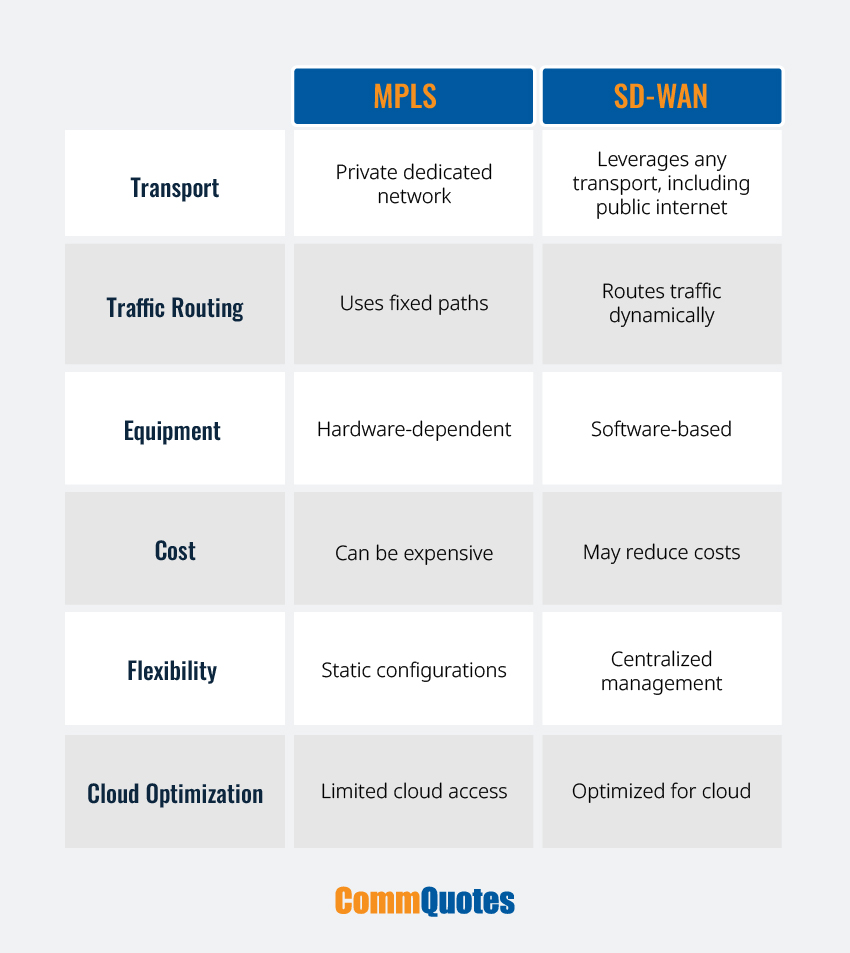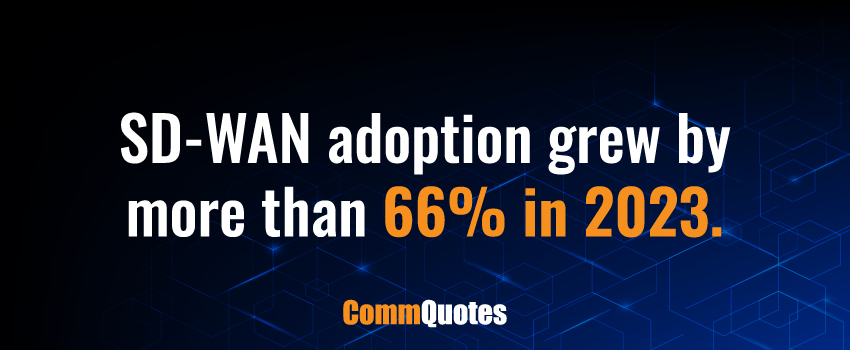MPLS networks have been the backbone of enterprise connectivity for over two decades. However, the rapid pace of digital transformation is making many businesses reconsider whether MPLS still meets their needs.
With the managed MPLS market forecast to reach $80.6 billion worldwide by 2028,1 it’s clear that many enterprises still depend on this reliable technology for connectivity. However, SD-WAN is increasingly popular – adoption grew by over 66% in 2023.2 This shift is driven by factors like cloud adoption, remote work, and mobile devices, which require businesses to have greater agility and flexibility from their networks.
In this blog, we’ll explore MPLS pros and cons to help you determine if it still fits your company’s long-term strategic goals, or if it’s time to make the switch to SD-WAN or a hybrid solution instead.
What Is an MPLS Network?
MPLS (Multiprotocol Label Switching) is a private network that transmits data using dedicated point-to-point connectivity between locations. It emerged in the 1990s as a solution to overcome the limitations of traditional IP routing.
MPLS technology creates a backbone structure that seamlessly interconnects an organization’s headquarters and branch locations. It establishes dedicated network paths between sites to tunnel network traffic securely, providing the reliability and performance needed for mission-critical activities like VoIP, video conferencing, and accessing centralized applications.
How Does MPLS Work?
An MPLS network works by assigning labels to data packets. These labels determine the network paths each data packet takes through the network, from ingress to egress, without needing to look up addresses in complex routing tables.
The components of an MPLS network include:
- Label Edge Routers (LERs) – LERs assign labels to incoming packets and remove labels from outgoing packets. The first LER is the ingress router, and the last is the egress router.
- Label Switching Routers (LSRs) – LSRs forward packets along label-switched paths (LSPs) through the MPLS network by reading labels and swapping old labels for new ones.
- Label-Switched Paths (LSPs) – LSPs are predetermined end-to-end packet delivery paths based on labels.
When a data packet enters the network, the ingress LER analyzes the IP header and assigns it a label containing the forwarding information. This label determines which LSP the packet should travel over.
Rather than re-analyzing the IP header, the LSRs along the LSP read the MPLS label to identify the next hop and swap the old label for a new one before forwarding. The egress LER then removes the label before sending the packet to its destination.
What Are the Top MPLS Advantages for Your Business?
MPLS networking offers businesses several benefits – which is why it’s remained a popular choice for global enterprises over the decades. The top advantages of MPLS for businesses include:
Reliability
With MPLS, packets are delivered securely over private, dedicated connections rather than the unpredictable public internet. Rigorous service level agreements (SLAs) guarantee network uptime and reliability, providing uninterrupted business operations and optimizing real-time voice and video communications via VoIP and unified communications.
Performance
The consistent low latency and jitter MPLS connections offer allows for effective real-time voice and video conversations. Predictable fast speeds help improve productivity by enabling collaboration tools to work optimally, and employees experience reduced congestion even during peak traffic times.
Scalability
Adding new locations is straightforward with an MPLS network’s backbone structure. Businesses can easily deploy additional sites and offices since the network can readily scale, simplifying onboarding for new locations.
Traffic Management
MPLS services allow IT teams to configure multiple classes of service to prioritize real-time traffic like voice and video over less sensitive traffic, guaranteeing high quality and performance for business-critical applications.
Security
Security vulnerabilities increased by 589% in 2023.3 MPLS connections are inherently resistant to cyber attacks, as traffic flows over private dedicated links that are completely isolated from the public internet. Malicious parties can’t access corporate data or applications from external networks, making MPLS an ideal choice for secure connectivity and data privacy.
Managed Service
An MPLS network is a fully managed network solution. The MPLS provider handles the day-to-day maintenance and management, freeing up IT resources for core initiatives and innovations that drive business value.

Are There Any Disadvantages of MPLS?
While traditional MPLS networks offer a wide range of benefits, there are some disadvantages to consider – particularly as more businesses adopt cloud apps and infrastructure. Potential disadvantages can include:
Inflexibility
Since these networks use fixed traffic paths, MPLS routers can’t divert traffic based on real-time conditions like traffic congestion or outages. Additionally, scaling and change requests can take significant time and resources to implement.
Vendor Lock-in
MPLS requires proprietary hardware routers and switches that only work with that particular vendor’s solution, leading to vendor lock-in for the entire network with very limited options. And because MPLS uses customized equipment, switching to a different service provider means a forklift upgrade by replacing all routers and other hardware.
MPLS vs. SD-WAN: What Are the Differences?
MPLS and SD-WAN take very different approaches to securely connecting multiple locations. Check out the chart below to see how these network solutions compare:

Key differences include:
- Transport – MPLS uses private dedicated connections like T1/E1 lines. SD-WAN connections can use any type of transport, like broadband, LTE, and MPLS.
- Traffic Routing – MPLS uses predetermined fixed paths to route traffic. SD-WAN routes internet traffic over the optimal path in real time, resulting in reduced network congestion.
- Equipment – MPLS requires proprietary hardware routers. SD-WAN is 100% software-defined and hardware-agnostic, reducing vendor lock-in.
- Cost – Installing and managing each MPLS connection can be expensive. In some cases, SD-WAN reduces costs by leveraging internet transport.
- Flexibility – MPLS configurations are static, which makes scaling difficult. SD-WAN allows IT teams to quickly add locations or modify policies from a centralized location.
- Cloud Optimization – MPLS backhauls cloud traffic through data centers. SD-WAN localizes network traffic to deliver LAN-like performance for cloud apps.
Can SD-WAN and MPLS Networks Work Together?
Leveraging SD-WAN can enhance your organization’s MPLS network. SD-WAN architecture abstracts the underlay network, transforming MPLS into one transport option along with cheaper connections like broadband and LTE. This allows businesses to retain their MPLS investment while realizing benefits like:
- Optimizing hybrid networks by balancing traffic across MPLS and the internet.
- Centralizing network management and monitoring through a single pane of glass.
- Gaining valuable visibility into network and application performance.
- Accessing cloud applications and resources directly via local breakouts.
- Implementing granular QoS policies to prioritize business-critical traffic.

SD-WAN enables advanced traffic shaping and dynamic re-routing that MPLS can’t provide on its own. Your IT team can use SD-WAN’s centralized orchestration to optimize MPLS connections alongside newer transport services like 5G.
How Does SASE Factor In?
SASE (secure access service edge) is an emerging cloud-based architecture that converges SD-WAN capabilities with security services like Secure Web Gateway, cloud access security broker, firewall as a service, and zero trust network access.
With a SASE model, organizations can provide consistent and secure access to applications for all users, regardless of where they’re located. Plus, SASE delivers networking and security functions as a unified cloud service deployed locally at the edge, so traffic doesn’t need to backhaul through centralized data centers. As more businesses adopt SASE frameworks to secure their distributed IT environments, MPLS and SD-WAN will both play essential roles in the network underlay.
Weigh the Pros and Cons of MPLS for Your Business With Help From CommQuotes
Evaluating whether your network still aligns with your goals is critical as your company’s needs evolve. While MPLS has served businesses faithfully for many years, the rise of cloud adoption and remote work has created the need for more dynamic, agile connectivity – which is where SD-WAN comes in.
There’s no one-size-fits-all approach to connectivity. If you’re not sure whether MPLS, SD-WAN, or a hybrid solution is right for your business, CommQuotes can help. Our technology experts can help you evaluate SD-WAN and MPLS and determine the best solutions to support your changing business needs both now and in the future. We leverage our VIP relationships with top providers to help you get the absolute lowest pricing and client experience possible so you can have the right networking technology and connectivity to keep your business online and growing.
Ready to get started? Reach out to CommQuotes today.
Sources:
- https://www.imarcgroup.com/managed-mpls-market
- https://www.techtarget.com/searchnetworking/feature/Trends-for-SD-WAN-managed-services
- https://www.forbes.com/sites/chuckbrooks/2023/05/05/cybersecurity-trends–statistics-more-sophisticated-and-persistent-threats-so-far-in-2023


